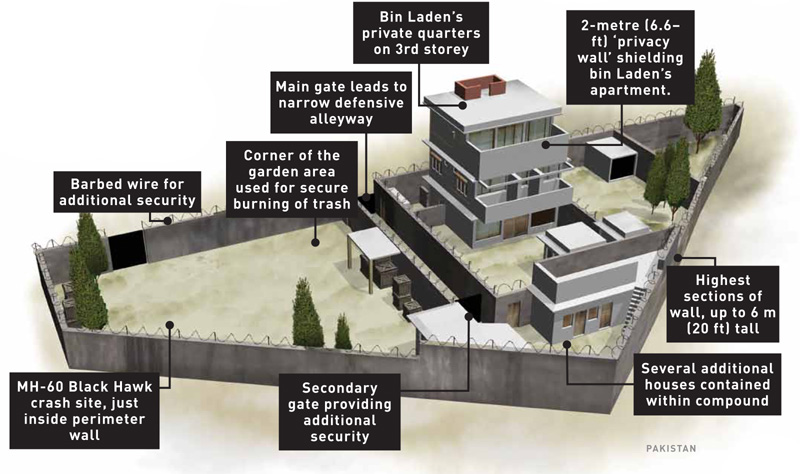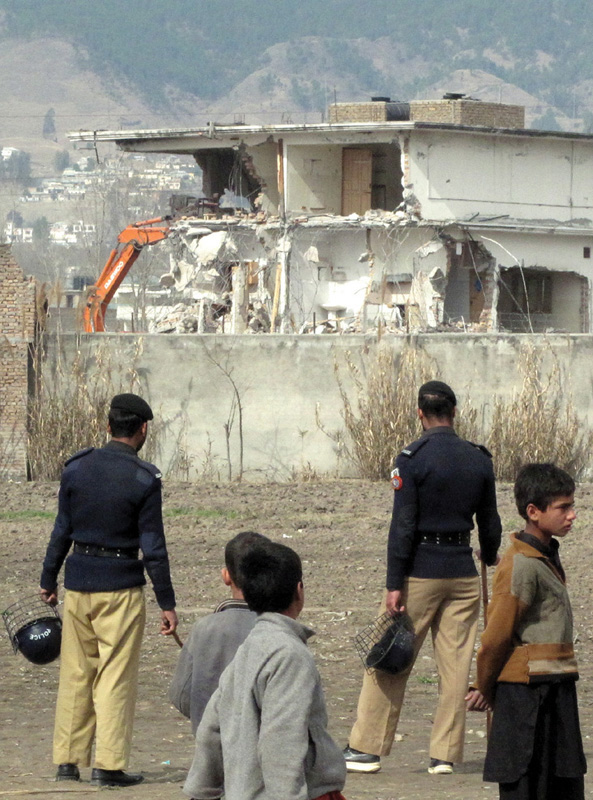
79 Osama bin Laden’s compound, Abbottabad
LOCATION Khyber Pakhtunkhwa, Pakistan
NEAREST POPULATION HUB Islamabad
SECRECY OVERVIEW High-security location: the long-hidden home of Osama bin Laden and, in 2011, scene of his death.
On May 2, 2011, American president Barack Obama announced to the world that US Navy Seals had finally tracked down and killed Osama bin Laden, the world’s most wanted man for the past decade. It would subsequently emerge that bin Laden had spent many of the years since his flight from Afghanistan living apparently unnoticed in a middle-class Pakistani town, just down the road from a military base.
The thriving town of Abbottabad lies in the Orash Valley of northern Pakistan. A popular stop on the tourist trail, it is surrounded on all sides by sweeping hills, and offers a gateway to the Karakoram Highway, following the route of the ancient Silk Road.
This moderate-sized town is named after a British army officer, Major James Abbott, who founded it in 1853. For many years, it has served as home to the Pakistan Military Academy, the training school for the nation’s army officers, and has a prominent population of retired military. All in all, its residents would tell you, Abbottabad is a pleasant and secure place in which to live.
Yet it was here that the man responsible for a number of atrocities, including the September 11, 2001 terrorist attacks on the USA, lived unhindered for at least five years. How that could have been is a mystery yet to be solved, and one that severely strained the bonds of trust between Washington and Islamabad.
Construction on what would become the bin Laden compound is believed to have been completed in 2005, and the owner was allegedly one Abu Ahmed al-Kuwaiti. Built within less than a mile of the Military Academy, the main building consists of three stories with at least eight bedrooms, and has a footprint of some 3,500 square meters (37,500 sq ft). It is surrounded by a concrete perimeter wall that rises between 4 and 6 meters (13 and 20 ft) in height, and is topped with barbed wire. There are relatively few windows, and the third floor (where bin Laden resided) is surrounded by a 2-meter (6.6-ft) high “privacy wall” of its own. Entry was via heavy security gates and there were numerous surveillance cameras in operation, though no provision existed for internet or telephone connections.

BEHIND CLOSED DOORS This view of the Abbottabad complex shows just how well protected and concealed its inhabitants were. Nonetheless, many in the international intelligence community have cast doubt on bin Laden’s ability to stay so long in hiding without the assistance of powerful figures within Pakistan.
Intelligence sources indicate that bin Laden probably moved to the premises on January 6, 2006. Its official address is House No. 3, Street No. 8-A, Garga Road, Thanda Chowa, Hashmi Colony, Abbottabad. However, it was given the nickname of Waziristan Haveli by locals. Haveli is the local word for a mansion, while Waziristan, ironically, is a region of Pakistan in which many commentators believed bin Laden had been sheltered for years.
Although the building’s structure was somewhat atypical, it did not immediately set alarm bells ringing. The locals noticed that the inhabitants kept themselves to themselves, and the house was not kept in the best state of repair. If local children were playing cricket nearby and batted a ball into the compound, the occupants gave them generous financial recompense for their loss, but the balls were never returned. This, it may be assumed, was as a security precaution. Nor did they ever dispose of their rubbish in the normal way—instead, waste was assiduously burned in an outside area. But all of this could perhaps be put down to eccentricity rather than anything more sinister.
Eventually, American intelligence forces began tracking al-Kuwaiti, whom they had identified as a bin Laden courier. After establishing that he resided in Abbottabad, it became clear that his home there had all the characteristics of a hide-away, and prolonged surveillance led to the conclusion that bin Laden could be the object of its protection. On May 2, 2011, in a raid codenamed Neptune Spear, 24 commandos arrived in Abbottabad from Afghanistan on two Black Hawk helicopters (one of which crashed and had to be abandoned), and took down the outer wall with explosives. They then raided the building within, engaging several other residents of the compound in fire fights before shooting bin Laden dead at around 1 a.m. After confirming his identity, they left with the body, which was later buried at sea.
Today, the compound is under the protection of the Pakistani police force. Sightseers, while allowed to approach the remaining parts of the external wall, are not permitted entry. It is believed that the Pakistani security services intend to destroy the building so that it does not become a shrine for jihadists. But before then it will be minutely scrutinized to discover just how it managed to hide its notorious occupant for so long.

DEMOLITION JOB Two security officials and a group of Abbottabad locals watch the destruction of the now-deserted bin Laden compound in February 2012. Once the site had been picked clean for evidence of Al-Qaeda operations, Pakistani officials were understandably eager to remove all trace of this embarrassing landmark.